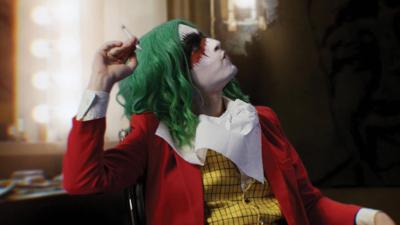Controversial from the jump with its 2022 Toronto Film Festival premiere — and followed immediately by an injunction from the powers that be at Warner Bros. Discovery — The People’s Joker has been a hot topic for a while now. It has spawned several kinds of questions, including “Is this legal?” and “Can I see this?” and “How well does this concept work?” And after a year-and-a-half of legal wrangling, some carefully timed film festival screenings and the nearly universal contempt for WBD chairman David Zaslav and his decisions about, well, pretty much everything except Barbie, The People’s Joker is finally unfurling its tendrils and planting a big purple-and-green kiss on the face of society.
Star, director and co-writer Vera Drew (she directed many episodes of On Cinema and edited the much-beloved and sorely missed Beef House, as well as Tim Robinson’s I Think You Should Leave) has created something special here — a deeply funny, imaginatively plotted trans and queer narrative that also manages to breathe so much life into the Schrödinger’s genre of comic book movies, now facing a slippery decline after ruling Hollywood for almost 20 years.
There’s certainly no comic book film in the past 20 years made with as much love as The People’s Joker. Drew and her crew of actors, artists, comedy freaks and gender theorists have managed to craft a film that feels like a whole comic book arc, with the different visual styles serving as a deeply effective metonymic device for the experience of going month to month with a story that has you hooked. And the story is a good one, steeped in DC Comics characters and lore, but also relatable to anyone who has dabbled in the chaotic and sometimes destructive world of stand-up comedy culture. (Of the many forces of chaos and destruction lurking in all manner of Crime Alleys and corporate boardrooms, the primary villain is Lorne Michaels — here voiced by icon Maria Bamford.) Oddly enough, by taking the attempts at Comic Book Movie Monoculture (the Marvel Cinematic Universe being particularly bad about trying to make everything look the same) out behind the bar and rolling them, The People’s Joker may be the kick-start/resuscitation that helps the genre find new ways to be relevant. It’s messy, sometimes monstrous and periodically moving.
In this Gotham City, a riot of high-concept and no-budget digital and analog animations (paying tribute to the work of legendary comic book artist Bill Sienkiewicz not in any specific style, but rather in the way that every scene has its own look best befitting the emotions of the material), comedy is under the iron fist of the government. The only path for Jokers (and the occasional Harlequin) is via the United Clown Bureau (a merciless skewering of both warhorse SNL and the financially icky Upright Citizens Brigade), a variety show/cult broadcast that is the only legal pathway to public humor. So our heroine, Joker the Harlequin (Drew), decides to make her own way in the world of absolute comedy genders, putting on avant-garde theater performances with other variants on Batman villains (personal fave — Nathan Faustyn’s Penguin, who broke his family’s hearts when he changed his major to think pieces) that skirt the nebulous edges of art, comedy and dragging one’s friends through the creative process.
In the midst of this gray-area performance art life, Joker the Harlequin meets Mistah J (Kane Distler), a transmasc Joker styled like Jared Leto’s take on the Clown Prince from David Ayer’s 2016 Suicide Squad film — “damaged” face tattoo and all. It’s a development that demonstrates that even this stylized riff on shared comic book history has some new things to offer mainstream movies, and this aspect of the film shines with Drew’s willingness to talk about issues that are usually kept within the community. Though you can’t help but realize that The People’s Joker is using these characters to open up whole new worlds, demonstrating the versatility (ha!) that comes with decades of personality shadings and the willingness to share toys. (Compare this with the forthcoming WBD-endorsed and -funded Harry Potter reboot that seems designed to calcify versions of beloved characters in the amber of a curdled creator’s desperate need to define their legacy by destroying it.)
This is a film that puts its cards on the table up front with a dedication to Joel Schumacher. (Would that I could give Saint Joel’s career the kind of thoughtful encapsulation Anthony Oliveira did for literary magazine Hazlitt.) Joker the Harlequin is visually engaging in a dialogue with Prince’s Gemini character from the 1989 Batman music videos, and I am all for that. The whole reason these superhero characters are perennial subjects of imaginations, fantasies and books that continue to sell is because they are elastic concepts more than capable of handling whatever we can throw at them. (This is also a film that will make you sad about what has become of Tumblr and seemingly every weirdo art space on the internet. Which is just another subset of the ongoing story of venture capital as the thing that devours the entire universe. Which is exactly what happened to WBD.)
If you look beyond the Smylex gas and the Lorne Michaels megalomania and the organized systems designed to stratify and control individual thought, The People’s Joker is still a visceral and visionary origin story. We occasionally get a flashback to Joker’s childhood, when an attempt to be real and honest causes a fracture between generations that is going to stick in the heart of anyone who is continually flummoxed by how so much of contemporary anti-trans legislation is rooted in parents thinking it’s about them, or meant to reflect on them — Li’l Joker says, “I promise I’ll never even tell you if I’m sad.” Those are the moments that make heroes and villains, and also that make exceptional movies.





